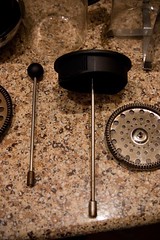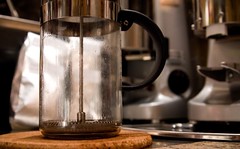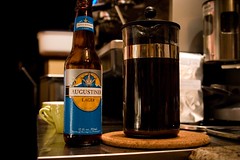These thoughts require a little background reading of one of the most important threads on
Coffeed.com:
The Third Wave and Milk-Based Drinks. The ostensible topic of the thread isn't what I'm thinking about, but where the discussion turns to whether or not cafes and coffee shops could stand up to competent critics, much like restaurants must.
Really this discussion cuts to the quick of my marketing whining (as seen in the last post)--we have no baseline definition of quality, whether in drinks or in ambiance. One question that I'm confronted with often from my staff is "what should it taste like?" and we spend hours each day thinking about it. The impression of what coffee and espresso should taste like from a consumer standpoint makes my head hurt. Not to mention the often obtuse tasting notes from "quality-oriented" roasters (note: I have had coffee that tasted like pink grapefruit and one that tasted like fresh-roasted peanuts, but those flavors were so overwhelming that the descriptions were more than apt). Same applies to roasting level--I've only met two people who *actually* like dark-roasted coffee, most folks I've met think dark roast is better because they've been told by some self-proclaimed coffee "authority" that dark is best for everything and everyone. We have no baseline.
Part of the problem, I think, is that we have assumed that coffee tastes a certain way and espresso tastes a certain way. Considering the sad state of coffee in this country (analogous to the state of tea and food in general), it is no surprise. I get chided for not carrying Lipton in the store, because it means "I don't sell tea". Same as when a gentleman tried to get us to sell Chock-full-o-nuts (one of the cheaper coffee brands) because, "They make it with 100% Colombian, which everyone knows is the best in the world!" Same as the marketing from the local gas chains coffee being "100% arabica beans", which they want people to interpret as "Our 99 cent coffee is made from the best beans in the world" but which actually means "We hope you don't realize that our marketing obfuscates much more than it clarifies and we hope you are too stupid to notice". With that sort of thing, Big Cream and Big Sugar team up with Big Coffee for Big profits. We have no baseline.
Building a baseline, though, whether in drinks or ambiance, is difficult. Not all coffees taste the same and even similar coffees, from similar regions or sometimes the same farms, taste different from season to season. Blends change from roast to roast. Percentages in each brew are contingent and ever-shifting.
The lack of a baseline is so frustrating because I've seen so many shops here and elsewhere that have attached themselves to a substandard of coffee because the owners/baristas have never
had good coffee. Their baseline is so low (and often driven by dreams of profit--ha!) that it is no wonder that people still don't like coffee...even owners and baristas.
They say you can't beat something with nothing. So, what should the baseline be? I don't think I can give a definitive answer, but I've got hints in a direction that we are following here. Coffee, regardless of brew method, should be (at least) palatable with cream, sugar, or additional flavorents. If not, something is wrong and (as an owner/barista) you need to find out what and change it or (as a consumer) you need to send it back and create the demand for the owner/barista to do their part. If your espresso blend does not taste good straight, but shines in milk drinks, let your customers know that. If your espresso blend does not hold up well in milk, but shines as a straight shot, let your customers know.
I would love to hear your opinions on this, whether you are a drinker, an abstainer, or a professional. Let's build the baseline here in Beaver County.
 First there were some problems to overcome. Many of the replies to the post mention that the French Press has a limited range and that some of the water at the bottom doesn't get a chance to brew. Using our McGyver-like tactics we contemplated how to construct a longer dowel rod to get the screen to the bottom of the French Press. While fabricating our own dowel rod would be awesome, the solution actually turned out to be much simpler. We have several Bodum French Presses and just unscrewed the dowel rod from a larger French Press and attached it to the lid and screen from a smaller one. Voila! Just like that we extended the rod and didn't even have to take any pills mentioned on late night TV infomercials!
First there were some problems to overcome. Many of the replies to the post mention that the French Press has a limited range and that some of the water at the bottom doesn't get a chance to brew. Using our McGyver-like tactics we contemplated how to construct a longer dowel rod to get the screen to the bottom of the French Press. While fabricating our own dowel rod would be awesome, the solution actually turned out to be much simpler. We have several Bodum French Presses and just unscrewed the dowel rod from a larger French Press and attached it to the lid and screen from a smaller one. Voila! Just like that we extended the rod and didn't even have to take any pills mentioned on late night TV infomercials! Once we fixed this problem, the other issue was how we should get the water in there. After some trial and error, we found the best way is to put the screen (and grounds) at the bottom of the French Press and pour water over it through the spout and swirl the French Press to get all the grounds wet.
Once we fixed this problem, the other issue was how we should get the water in there. After some trial and error, we found the best way is to put the screen (and grounds) at the bottom of the French Press and pour water over it through the spout and swirl the French Press to get all the grounds wet. While this produced a great cup, I'd like to continue working to improve the reverse French Press. I'd like to use a finer grind for this reverse method, as the Clover tends to use a finer grind to achieve a fast brewing time. Sweet Maria's sells a nylon filter that could allow for a finer grind to be used. Another area of interest is how much the vacuum effect of the Clover contributes to the cup and how it could be implemented. Hopefully this is only the start of the 'Ghetto Clover' and that BFCAT and others will contribute to new designs and new ideas. Any ideas on how it could be improved?
While this produced a great cup, I'd like to continue working to improve the reverse French Press. I'd like to use a finer grind for this reverse method, as the Clover tends to use a finer grind to achieve a fast brewing time. Sweet Maria's sells a nylon filter that could allow for a finer grind to be used. Another area of interest is how much the vacuum effect of the Clover contributes to the cup and how it could be implemented. Hopefully this is only the start of the 'Ghetto Clover' and that BFCAT and others will contribute to new designs and new ideas. Any ideas on how it could be improved?
